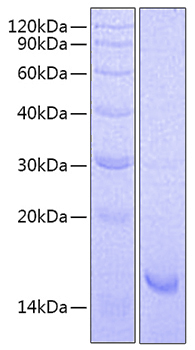Description
Size quantity : 1-EA
Description : Interleukin-21 (IL-21) is an approximately 14 kDa four-helix-bundle cytokine in the family of cytokines that utilize the common gamma chain ( gamma c) as a receptor subunit. gamma c is also a subunit of the receptors for IL-2, IL-4, IL-7, IL-9, and IL-15 . IL-21 is produced by activated T follicular helper cells (Tfh), Th17 cells, and NKT cells. It exerts its biological effects through a heterodimeric receptor complex of gamma c and the IL-21-specific IL-21 R. Tfh-derived IL-21 plays an important role in the development of humoral immunity through its autocrine effects on the Tfh cell and paracrine effects on immunoglobulin affinity maturation, plasma cell differentiation, and B cell memory responses . It is also required for the migration of dendritic cells to draining lymph nodes . IL-21 regulates several aspects of T cell function. It co‑stimulates the activation, proliferation, and survival of CD8+ T cells and NKT cells and promotes Th17 cell polarization . It blocks the generation of regulatory T cells and their suppressive effects on CD4+ T cells. IL-21 R engagement enhances the cytolytic activity and IFN-gamma production of activated NK cells but limits the expansion of resting NK cells . In addition, IL-21 suppresses cutaneous hypersensitivity reactions by limiting allergen-specific IgE production and mast cell degranulation . Dysregulation of the IL‑21/IL‑21 R system contributes to the development of multiple immunological disorders . The mouse IL‑21 precursor contains a predicted 17 amino acid (aa) signal sequence and a 129 aa mature chain. Mature mouse IL-21 shares 66%, 59%, 58%, and 88% aa sequence identity with mature canine, human, rabbit, and rat IL-21, respectively.


